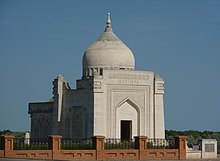Kurmangazy Sagyrbaev
This article needs additional citations for verification. (April 2007) |
Kurmangazy Sagyrbayuly | |
|---|---|
 1998 Kazakhstan stamp, for the 175th anniversary of his birth | |
| Born | 1823 Zhideli village, Bokey Orda District, West Kazakhstan Region |
| Died | 1896 (aged 73) |
| Citizenship | Bukey Horde |
| Occupation | Composer |
| Notable work | "Sary-Arqa" |
Kurmangazy Sagyrbayuly (Kazakh: Құрманғазы Сағырбайұлы, Qūrmanğazy Sağyrbaiūly; 1823–1896)[1][2] was a Kazakh composer, instrumentalist (kobyz, dombra), and folk artist.[3] He influenced Kazakh musical culture. He was born in 1818 in the Bukey Horde (now Zhanakala District, West Kazakhstan Region). He is buried in the Astrakhan region of Lower Volga in today's Russian Federation.[4]
Legacy
[edit]In 1993, Sagyrbaev's image has been used on the 5 Kazakhstani tenge banknote, and on a Khazakh stamp in 1998.[1]
The Kazakh National Conservatory is officially named after Kurmangazy.[5]
Works
[edit]The time when Kurmangazy lived, especially the period when he became aware of his surroundings and actively engaged in life, was highly complex. This was the era when the colonial policies of Tsarist Russia were at their peak—greedy, oppressive, and increasingly ruthless. In times of hardship, the burden of calamity always falls first on the shoulders of the most resilient individuals. The turmoil of the era also left its mark on Kurmangazy, testing him with fire and trials. His compositions such as "Tүрмеден қашқан" (Escaped from Prison), "Кісен ашқан" (Breaking the Shackles), "Ертең кетем" (Leaving Tomorrow), "Бозқаңғыр" (Bozqangyr), "Пәбескі" (Carriage), "Терезеден-есіктен" (Through the Window and Door), "Бозшолақ" (Bozsholak), "Бұқтым-бұқтым" (Buktym-Buktym), "Ne krichи, ne shumi" (Do Not Shout, Do Not Make Noise), "Арба соққан" (Wagon Maker), "Аман бол, шешем, аман бол!" (Farewell, Mother, Stay Safe!), "Қайран шешем" (My Dear Mother)—serve as milestones of the hardships imposed by the times. He responded to every challenge of his harsh fate through his art, leaving his mark with his music.
Kurmangazy was a composer deeply in love with life. He could rejoice like a child at the bright moments of existence and immerse himself in pure emotions. His compositions such as "Қызыл қайың" (Red Birch), "Ақжелең" (Akzhelen), "Адай" (Adai), "Сарыарқа" (Saryarka), "Балбырауын" (Balbyrauyn), "Серпер" (Serper), "Назым" (Nazym), "Балқаймақ" (Balkaymak), "Бұлбұлдың құрғыры" (Cursed Nightingale), "Ақсақ киік" (Lame Antelope), "Төремұрат" (Toremurat), "Қуаныш" (Joy) reflect the heartbeat of a soul deeply passionate about life.
What sets Kurmangazy apart as a unique artist is his conceptual approach to composition. He was not just reflecting on the fate of one or two generations but delved deeply into historical phenomena that shaped multiple generations. This ability to contemplate and interpret significant societal changes was an essential part of his spiritual identity. His compositions such as "Жігер" (Ziger), "Көбік шашқан" (Foaming Waves), "Кішкентай" (Kishkentai), "Ақбай" (Akbai) serve as the reflections of a philosophical composer, offering his assessment of the historical and social realities of his time.
Similarly, his compositions such as "Айжан-ай" (Aizhan-ai), "Айда бұлбұл" (Sing, Nightingale), "Алатау" (Alatau), "Амандасар" (Greeting), "Бас Ақжелең" (Main Akzhelen), "Демалыс" (Rest), "Лаушкен" (Laushken), "Ойбай, балам" (Oh My Child), "Саранжап" (Saranjap), "Теріс қақпай" (Reverse Kakpay), "Ұзақ Ақжелең" (Long Akzhelen) are widely known.
Kurmangazy’s soaring spirit cannot be confined to the realm of music alone. A talent of such immense power serves as a testament to the spiritual identity of an entire nation. The great historical transformations in a nation’s destiny are always intertwined with the fates of its extraordinary sons and daughters. In this sense, Kurmangazy was not only an unparalleled artist but also a living embodiment of his people's essence, reflecting the turbulent and chaotic era he lived in. With his powerful compositions, he carried the weight of his time without breaking, just as Makhambet did in poetry, Shoqan in science, and Kenesary on the battlefield—remaining steadfast in his indomitable spirit.
References
[edit]- ^ a b Kazakhstan 5 Tenge Banknote.ws
- ^ Axel Frey, ed. (2005). Biographischer Index Rußlands und der Sowjetunion [Biographical Index of Russia and the Soviet Union] (in German). Walter de Gruyter. p. 1160. ISBN 9783110933369.
- ^ Kurmangazy Sagyrbaev Madenimura.kz Archived 2019-05-27 at the Wayback Machine
- ^ Monument of Kurmangazy Sagyrbaev atyrautourism.kz Archived 2016-05-10 at the Wayback Machine
- ^ Kassymova, Didar; Kundakbayeva, Zhanat; Markus, Ustina (2012). Historical Dictionary of Kazakhstan. Scarecrow Press. p. 167. ISBN 9780810879836.
External links
[edit] Media related to Kurmangazy Sagyrbayuly at Wikimedia Commons
Media related to Kurmangazy Sagyrbayuly at Wikimedia Commons

